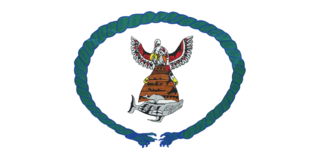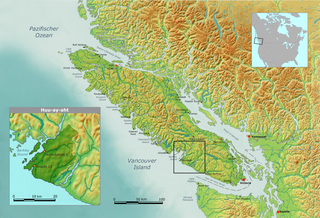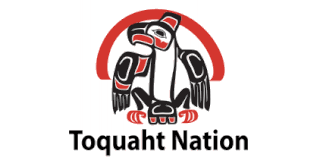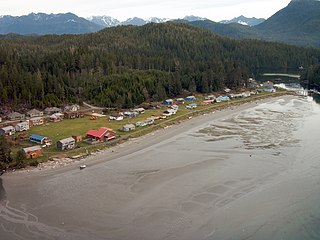
Clayoquot Sound is located on the west coast of Vancouver Island in the Canadian province of British Columbia. It is bordered by the Esowista Peninsula to the south, and the Hesquiaht Peninsula to the North. It is a body of water with many inlets and islands. Major inlets include Sydney Inlet, Shelter Inlet, Herbert Inlet, Bedwell Inlet, Lemmens Inlet, and Tofino Inlet. Major islands include Flores Island, Vargas Island, and Meares Island. The name is also used for the larger region of land around the waterbody.

The Nuu-chah-nulth, also formerly referred to as the Nootka, Nutka, Aht, Nuuchahnulth or Tahkaht, are one of the Indigenous peoples of the Pacific Northwest Coast in Canada. The term Nuu-chah-nulth is used to describe fifteen related tribes whose traditional home is on the west coast of Vancouver Island.

The Tla-o-qui-aht First Nations are a Nuu-chah-nulth First Nation in Canada. They live on ten reserves along the Pacific Rim National Park Reserve on Vancouver Island, British Columbia. The band is part of the Nuu-chah-nulth Tribal Council. There were 618 people living in the Tla-o-qui-aht reserves in 1995. Their primary economic activities are fishing and tourism.

Tseshaht First Nation is an amalgamation of many tribes up and down Alberni Inlet and in the Alberni Valley of central Vancouver Island in the Canadian province of British Columbia. They are a member of the Nuu-chah-nulth Tribal Council which includes all other Nuu-chah-nulth-aht peoples except the Pacheedaht First Nation.

The Yuułuʔiłʔatḥ Government or Ucluelet First Nation is the modern treaty government of the Yuułuʔiłʔatḥ in the Canadian province of British Columbia.
The Nuu-chah-nulth Tribal Council is a First Nations Tribal Council in the Canadian province of British Columbia, located on the west coast of Vancouver Island. The organization is based in Port Alberni, British Columbia.

The Ahousaht First Nation is a First Nation government based on the west coast of Vancouver Island in British Columbia, Canada. It administers the community of Ahousaht, British Columbia, which encompasses much of Clayoquot Sound. The Ahousaht are a member of the Nuu-chah-nulth Tribal Council. It is led by Chief A-in-chut Shawn Atleo and the Taayi Haw̓ił - Maquinna.

The Ehattesaht First Nation is a First Nations government covering about 660 km^2 on the West Coast of Vancouver Island in the British Columbia, Canada. It is a band that is one of the 14 Nuu-Chah-Nuulth Nations and is now a member of the Nuu-chah-nulth Tribal Council. In the modern-day, there are currently only 539 registered members as of October 2021. with a language that has been lost over the years as the British Columbia government states that there are only 52 speakers of the language.

The Huu-ay-aht First Nations is a First Nations band government based on Pachena Bay about 300 km (190 mi) northwest of Victoria, British Columbia on the west coast of Vancouver Island, in Canada. The traditional territories of the Huu-ay-aht make up the watershed of the Sarita River. The Huu-ay-aht is a member of the Nuu-chah-nulth Tribal Council and is a member of the Maa-nulth Treaty Society. It completed and ratified its community constitution and ratified the Maa-nulth Treaty on 28 July 2007. The Legislative Assembly of British Columbia passed the Maa-nulth First Nations Final Agreement Act on Wednesday, 21 November 2007 and celebrated with the member-nations of the Maa-nulth Treaty Society that evening.

The Toquaht Nation is a modern treaty government located on the west coast of Vancouver Island in British Columbia, Canada. It is a member of the Maa-nulth Treaty Society and the Nuu-chah-nulth Tribal Council.

The Nuchatlaht First Nation is a First Nations government based on the west coast of Vancouver Island in British Columbia, Canada. It is a member of the Nuu-chah-nulth Tribal Council.
Kyuquot Sound is a complex of coastal inlets, bays and islands on northwestern Vancouver Island in the Canadian province of British Columbia.

The Uchucklesaht Tribe, or Uchucklesaht First Nation, is a modern treaty government located on the west coast of Vancouver Island in British Columbia, Canada. It is a member of the Maa-nulth Treaty Society and the Nuu-chah-nulth Tribal Council.

Opitsaht, spelled also as Opitsat and Opitsitah, is a Tla-o-qui-aht settlement/community in the Southwest area of the Meares Islands, Clayoquot South, British Columbia. This peninsula-like region is the home to the Tla-o-qui-aht people from the Nuu-chah-nulth nation, a tribe from the Pacific Northwest region in the lower Vancouver area, known for their lifestyle revolving around the marine life trade and culture within the community.
The Clayoquot Sound Central Region Board (CRB) was created as a result of the historic two-year Interim Measures Agreement (IMA) in 1994. This agreement acknowledged that "the Ha'wiih of the First Nations have the responsibility to conserve and protect their traditional territories and waters for generations which will follow". The IMA was a negotiated agreement between the Central Region Chiefs (CRC) and the Province of British Columbia to define the terms of co-management of land and resource use and operations during treaty negotiations.
The Nuu-chah-nulth Economic Development Corporation (NEDC) was incorporated in 1984 under the Canada Corporations Act as a not-for-profit organization. Although it is not tied directly to the Nuu-chah-nulth Tribal Council (NTC), the NEDC was formed to help the Nuu-chah-nulth people achieve economic and social independence by providing financial assistance and advisory services. NEDC manages a number of funding programs aimed at enhancing economic development in the region.
The Nuu-Chah-Nulth Employment and Training Program (NETP) is a program that seeks to help all aboriginal people with education and training. The overall mission of the NETP is to increase the quality of life, self-reliance and economic prosperity of aboriginal people and organizations within the Nuu-chah-nulth Tribal Council region by supporting and empowering career and employment aspirations.
Uu-a-thluk is the aquatic management organization of the Nuu-chah-nulth people on Vancouver Island, British Columbia.
Co-management, also known as community-based management, community-based resource management, cooperative management, joint management, and collaborative management, in the broadest terms refers to the administration of a particular place or resource being shared between multiple local and state management systems. Although co-management encompasses a spectrum of power-sharing arrangements, in the Canadian context it typically refers to agreements between government agencies and representatives of Indigenous peoples in Canada to jointly make land use and resource management decisions about a tract of government-controlled land or resource (e.g.fishery.).

Whaling on the Pacific Northwest Coast encompasses both aboriginal and commercial whaling from Washington State through British Columbia to Alaska. The indigenous peoples of the Pacific Northwest Coast have whaling traditions dating back millennia, and the hunting of cetaceans continues by Alaska Natives and to a lesser extent by the Makah people.












